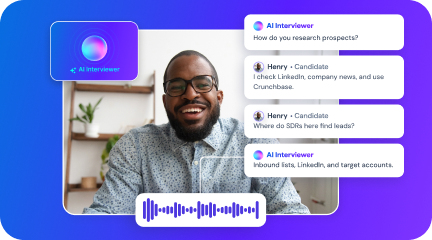Welcome back to our mini-series of The Debrief podcast, Masters of Sales Hiring. Hosted by BrightHire Co-Founder Teddy Chestnut, the series features conversations with today’s top sales leaders, sharing their candid stories about building world-class sales teams.
Today’s guest is Holly Procter, SVP – Global Head of Sales at Clari. Over her time leading sales teams at LinkedIn, WeWork, and Clari, Holly has concluded that the saying “a great seller is a great seller” isn’t always true. Instead, she’s learned to hire people who have the right skills for the company’s sales environment.
In the conversation, Holly shares how to assess your company’s environment and determine the skills you should be hiring for, how to hire for potential vs. experience, what to look for in internal and external leadership candidates, and how to build the right team when expanding into new markets.
Check out the highlights from our conversation:
The biggest lesson Holly learned as a sales leader at WeWork. (01:22) – At WeWork, sellers are working with limited inventory: office space. If two buyers show up for a tour, only one can take the space. One of the primary things Holly looked for when hiring candidates at WeWork was a seller who could derive urgency really effectively. But that’s not something she hires for now at Clari. This experience taught Holly one critical thing: take the time to pause at every new company to consider what is required for that environment.
How to hire the right sales reps for your environment. (04:42) – Holly says determining how to build the right sales team for your company comes down to a few key things:
- What you’re selling
- What stage your company is at and the market education required
- Where your company fits into the Crossing the Chasm lifecycle
Hiring for potential vs. experience. (06:10) – When Holly decides who to hire, she takes into account how they classify wins in their business. For late-stage companies, a win is closed-won revenue. But when building a company from scratch, like at Clari, wins for that seller profile are measured differently. Instead, success could look like getting someone to respond to an email or creating a new talk track. If the only thing a rep considers a win is bookings, they’ll likely feel like a failure in an environment like Clari’s.
Signs you should promote an internal candidate into a leadership role. (09:40) – Holly has a bullet-proof formula for promoting internal candidates into leadership roles. She always asks herself two things:
- Is it clear and obvious? A great leadership candidate will come as no surprise to their team.
- Are they already operating in a capacity that makes the leap minimal? For example, do they have a point of view on how to assess talent? Are they already leading team meetings? Those are signs that it will be easy for them to take the next step.
Ways to determine if an external candidate is a good fit for leadership. (11:18) – When you’re making a bet on performance vs. potential for external leadership candidates, there are a few key data points to consider. For example, do they have prior leadership experience? Can you translate the ingredients you see inside of them through the environment that they’re walking into?
How to avoid bringing over the wrong people. (13:03) – One tough lesson Holly’s learned over her career is that sometimes bringing people with you from a previous company doesn’t translate well. When this happens, it’s really painful to course correct. To avoid bringing over the wrong people, ask your hiring team to critically assess the candidates for fit. Let them know that you might have a bias, so they should assume that the candidate has no attachment to you and should avoid giving the candidate a pass just because you know them.
The most important things to get right when expanding into new markets. (18:52) – Holly recently led Clari’s expansion into APAC. The experience taught her four key things:
- Start the hiring process early. Begin recruiting for a new hire months in advance.
- Really invest in your first hire. This is important because they need to be an extension of you. However, you will have limited ability to influence them due to the minimal overlap in working hours.
- Find someone who can wear many hats. The ability to flex roles was so critical for Clari’s first APAC hire. Not only did they serve as the sales leader, they also had to pinch hit for SDR and AE responsibilities while the team was growing.
- Learn about the market from candidates. Holly met with more than 30 candidates when they were expanding into APAC to learn about the market. Even if they weren’t the right fit for the role, Holly used the interviews as an opportunity to learn.
Listen to Holly’s podcast episode or watch the entire conversation below:
Missed the last session of The Debrief? Catch up on our conversation with Sean Murray, CRO at Greenhouse Software.









